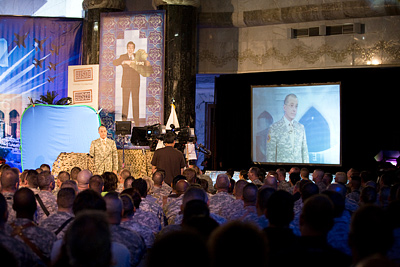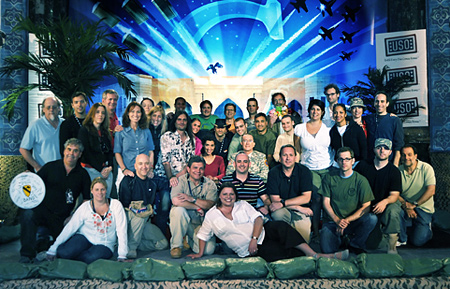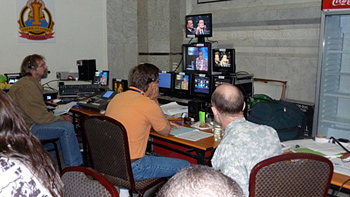Colbert Goes Commando in Iraq
NEW YORK
To get a taste of what it means to be part of Operation Iraqi Freedom, Comedian Stephen Colbert subjected himself to the full Army experience—soldiering up, pushing through basic training, eating dust in Baghdad, and even getting a buzz cut.
While his efforts to enlist failed to impress the military, the four shows his team produced from Camp Victory in Baghdad—for his popular Comedy Central series "The Colbert Report"—successfully overcame the logistical and technical challenges of doing TV from a war zone while maintaining Colbert's clever brand of hilarious antics and insightful humor.
Each of the Baghdad shows were shot "live to drives," June 7-9, 2009 before an audience of 500 American troops in the spacious atrium of the Al-Faw—Saddam Hussein's lavish palace that now serves as the U.S. military headquarters for the Iraq War. This special remote undertaken by "The Colbert Report" was facilitated by extensive support from the USO and the U.S. military.

Stephen Colbert in front of the blue screen for the "Formidable Opponent" segment. Photo by Andro BunetaSHOOTING IN BAGHDAD
Preproduction began in early spring with a trip to Baghdad to scout out the locations to determine what resources were available locally and what would need to be shipped over.
"Since our goal was to replicate the production quality and spontaneity of our New York-based studio show over in Baghdad, one of the biggest challenges we faced was that we were constrained in the amount of equipment we could transport to Baghdad because we were relying on military transport. When we realized how much equipment we would actually need to ship, we had to be extremely resourceful and judicious in deciding just what to bring," said Tanya Michnevich Bracco, supervising producer for "The Colbert Report" and line producer for the Iraq shows. "Also, with no technical support there, we had to come up with backup plans for every part of our workflow. We had to think outside the box."
While USO productions typically involve transporting two or three palettes of gear and a few people, "The Colbert Report" needed to transport a 30-member crew and over 13 palletes of gear, done over three separate trips. This meant filling the interiors of C130 and C17 military cargo planes with people in helmets and flak jackets—including editors, camera operators, and writers—and production elements such as sets, props, theatrical lighting, editing systems, and audio gear, not to mention office equipment. The military dedicated over 200 troops to assist in construction and setup of the facility, as well as logistical support and housing for the crew.
"Given the opportunity, we would have pre-fabricated a high-end production control room or even a flypack in New York and moved it over to Iraq ready to go. But we didn't have the luxury to ship such large cargo," said Jeremy Tchaban, production manager for "The Colbert Report." "As a result, we had to supplement our equipment complement with video cameras, production switchers, and monitors from a local source, Coaxial, a Kuwaiti event production company; and this meant we would have to work in PAL, the native format in that part of the world."
DRY RUN
In the weeks prior to the remote, Tchaban and "The Colbert Report's" technical and engineering team rented the PAL equipment they would be using in Iraq to run tests and technical run-throughs to ensure flawless integration and workflow.

The Colbert team that went to Iraq. Photo by Steve Manuel "All of the field packages we shot and edited in NTSC in the states had to be converted to PAL to maintain a consistent format," said Tchaban. "We also had concerns about how standards conversion and compression with the satellite transmission would impact the quality of the video. At first, the video sent from Iraq to New York looked soft and fuzzy but after a few changes in the transmission path we were able to achieve acceptable broadcast quality video."
When they finished the live recordings and some post production to tighten them up, the shows were sent via satellite by a military service called DVIDS to their downlink in Atlanta where it was converted back to NTSC using a Snell Alchemist standards converter and forwarded via fiber to "The Colbert Report" studio for online finishing, color correction, and relaying high resolution graphics. The show was then transmitted via fiber to MTV/Viacom's network operations center in New York for broadcast.
APPEARING AT THE PALACE
The PAL camera package consisted of four Sony DSR-400 field cameras—three on tripods and one on a 20-foot jib.
"Every member of our technical team from lighting, to audio, to post overcame obstacles posed by taping in a war zone with limited manpower and equipment," Tchaban said.
"Given the technical constraints there, the biggest challenge we faced was creating a live show that would really entertain the troops and get natural laughs, while still delivering to home viewers a product comparable in quality to what they'd come to expect from us," said Jon Pretnar, technical director for "The Colbert Report." "We got around this by essentially doing two shows, one live with the technology at our disposal, and a version that was finessed in post for our home audience."
For example, the most complex, blue screen effect was created live for "Formidable Opponent," a segment where Colbert appears live in both sides of a split-screen simultaneously and debates himself about a controversial issue; this time the "Don't Ask, Don't Tell" policy. While this live split-screen effect is no problem at all for the big Sony switcher back home, Pretnar said that, for the Iraq shows, he needed to use two of the small switchers at once.
"I used the Panasonic switcher to cut between the two cameras on Stephen, to add the chromakey, and flip the video back and forth; and I used the Sony switcher to cut between two backgrounds that were keyed behind the shots," Pretnar said.

(L to R): Jon Pretnar, TD, Jim Hoskinson, directing, and Gen. Jacoby watch the taping of 'The Colbert Report.' Photo by Tanya Braco Compared to the 3.5-M/E Sony-9000 switcher that has enormous firepower back at the New York studio, Pretnar only had three 4-input analog PAL switchers at his disposal: a Panasonic with chromakey; a Sony for cuts-only, and an Extron that fed composite video graphics to the two rear projectors on stage.
"Pretnar was punching up buttons on the three switchers as if he were playing three pianos at once," Tchaban said, "so the gags would be staged with the full live effects to capture the natural laughs we wanted from the troops."
According to Pretnar, "Since the Sony DSR-400 digital camcorders were also recording all the video as ISO's, our Avid editors could finesse this video footage in post. They also added reference graphics—for segments such as 'The Word'—so that our New York production team would then be able to see where we intended to insert graphics, such as over-the-shoulder pictures we couldn't put in here. And they would then insert these graphics into the 'clean line cut' version we sent them so that the text wouldn't suffer quality degradation due to the compression and satellite transmission."
For the recurring segment known as "The Word," the audience normally sees Stephen delivering commentary on one side of a live split screen display, with the corresponding punch line/bullet points animating onto the other side. But for the Iraq shows, the troops saw Stephen sitting at his desk while only the text could be seen on rear screen displays. Later in post, the full effect was finished on Avids before being sent to New York.
AVID ADVANTAGE
In searching for powerful yet compact solutions, Bracco and Tchaban determined that when Mac laptop-based Avid Media Composer 3.0 editing systems were coupled with Avid MOJO DX boxes, the footprint was small yet covered the needs of both high-end post production and studio control room requirements. This was all possible because of MOJO's realtime effects processing, as well as video and audio ingest and play-out features.
With extensive technical consultation by Avid's Kevin Camoosa, the team decided to take four editing laptops—one for playback, two for editing, and one backup—and three MOJO DX's. The Avids were put in the video post-production area—which along with makeshift control room, audio and storage areas—were set up on four six-foot folding tables in the ballroom adjacent to the atrium.
While all the shows went off without a hitch, a last minute request for a special prop—a "Risk" board game—almost stumped them. Tchaban said, "I asked a few soldiers if anyone on the base knew where we could get Risk, and within 15 minutes they had managed to find us one in the middle of a war zone."
Bracco said, "I can speak for the entire group when I say that bringing our show to the troops was professionally and personally an unforgettable experience."
Get the TV Tech Newsletter
The professional video industry's #1 source for news, trends and product and tech information. Sign up below.

